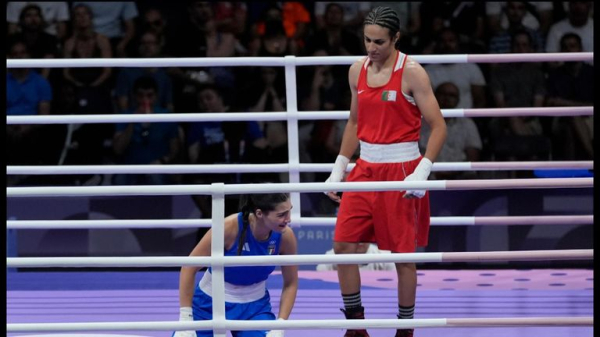
By the time Angela Carini emerged from the Paris North Arena, she seemed drained.
But the Italian boxer was not obviously reeling in pain after earlier abandoning her bout after 46 seconds in one of the most contentious contests ever seen at an Olympics.
Decrying the unfairness, Carini claimed her nose might have been broken by the powerful punches of Imane Khelif after insisting she could not fight on.
The blows seemingly as ferocious as the row. But everything that unfolded at the Olympics yesterday was as feared as it was foreseen during days of debate.
Some asked why was Khelif even allowed in the ring, given past concerns about the Algerian’s testosterone advantages.

Outside the arena, I encountered Marissa Williamson who recently fought Khelif and reflected on the delicate discussions.
“Keep it fair,” the Australian boxer told Sky News. “It’s not fair to target an individual, it’s not fair to put other people at risk. So the conversations need to be held at the highest level.”
It was only last year Khelif was disqualified from the world championships for failing unspecified gender eligibility requirements.
But this fight blew into the open a debate – steps removed from sport’s transgender inclusion discord – about the rights of an athlete to compete.
Does a potential strength advantage, with inherent dangers, outweigh the desire to be inclusive and non-discriminatory?

And at the heart of it all, Khelif, who just wants to fight. Whose attempts to console, comfort or reassure were rejected by the tearful rival who had been on the receiving end of those punches in the 46 seconds the bout lasted.
For days the very staging of this 66kg opening-round fight had been questioned but it also collided with a long-running dispute between the International Olympic Committee and the International Boxing Association.
It was IBA that ran the world championships that declared Khelif ineligible.
The IOC now calls that a “sudden and arbitrary decision … without any due process” against Khelif and Taiwanese fighter Lin Yu‑ting – who won her first match of the 2024 Olympics in Paris on Friday.
A combination of concerns about integrity and the IBA’s funding from the Russian state saw the IOC take control of boxing at the Olympics – with the sport threatened with being thrown out of the Games entirely.

That put the IOC at the forefront of this thorniest of eligibility issues, confronted with questions on camera during the daily Paris 2024 briefings (a level of public accountability that is far from universal across sport).
There were warnings against stigmatising Khelif and a “witch hunt” over her eligibility.
IOC spokesman Mark Adams attempted to shut down any uncertainty by insisting: “They are women in their passports and it’s stated that this is the case, that they are female.”
The IOC wants rules based on scientific evidence, although an athlete female at birth but considered a biological male could expose rivals to harm in competitions through physical advantages.
But science can require interpretations.
“Testosterone is not a perfect test,” Mr Adams said. “Many women can have testosterone which is in what would be called ‘male levels’ and still be women and still compete as women.

“So this panacea, this idea that suddenly you do one test for testosterone and that sorts everything out – not the case, I’m afraid.”
World Athletics has grappled with competitors with differences in sex development (DSD) – notably the two-time Olympic 800m champion Caster Semenya.
Returning to competing in that competition would require her to undergo hormone-suppressing treatment for six months.
When I asked about the boxing case, World Athletics President Sebastian Coe said: “If you have a clear-cut policy, however tough that decision is to arrive at, you have the policy. If you don’t, then that is a challenge and boxing has a challenge.”
Which brings it back to whose rights to fairness take priority.
Is it fair to fear being put in danger by someone far stronger in a combat sport?

Is it fair to exclude someone female at birth who has gone through no treatment to adjust testosterone levels that would gain a competitive advantage?
Mr Adams, of the IOC, said: “This involves real people and we’re talking about real people’s lives here.
“They have competed and they continue to compete in the women’s competition. They have lost and they’ve won against other women throughout, over the years.
“And by the way, this isn’t, should make this absolutely clear for everyone, this is not a transgender issue.”
But the issue is not going away from the Olympics however much its leadership is asking everyone to “dial it down”.

